Terap
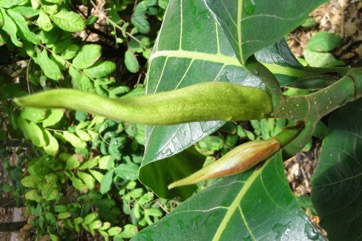
A tropical tree. It suits the hot, wet tropical lowlands. It prefers a warm humid climate. It can be damaged by temperatures below 5°C. Occurs only in Mindoro, Mindanao and Basilan but apparently fairly common in Mindoro, Cotabato, Lanao, Davao, Zamboanga and Basilan in the Philippines. In Indonesia it grows in lowland forest and up to 1,000 m altitude. Brisbane Botanical Garden.
Also known as:
Beluli, Benturung, Jarap hutan, Keiran, Kian, Loloi, Lumok, Lumuk amat, Madang, Marang-banguhan, Marang, Morang, Muntorong, Pi-ien, Pingan, Tarap, Tekalong, Terap, Timadang
Synonyms
- Artocarpus tarap Becc.
- Artocarpus mutabilis Becc.
Edible Portion
- Fruit, Seeds, Nuts, Vegetable
Where does Terap grow?
Found in: Asia, Australia, Brazil, Brunei, Indonesia, Malaysia, Mauritius, Myanmar, North America, Pacific, Philippines, SE Asia, South America, United States
Notes: There are about 50 Artocarpus species. They are in the tropics and subtropics of Asia and the Pacific.
Status: It is a cultivated food plant. The fruit is good tasting.
Growing Terap
Cultivation: Plants are grown from seed. Fresh seed is washed then planted immediately. Seed germinate in about 4 weeks. Plants are spaced 12-14 m apart. Plants can be grafted.
Edible Uses: The fleshy portion of the fruit is eaten raw. It is sweet. The seeds are eaten roasted or boiled. The unripe fruit can be cooked as a vegetable.
Production: A tropical tree. Trees produce after about 4-6 years. The spines on the fruit snap when the fruit is ripe. The fruit have to be picked from the tree as it doesn't fall. A tree produces about 180 fruit per season.
Nutrition Info
per 100g edible portion| Edible Part | Energy (kcal) | Protein (g) | Iron (mg) | Vitamin A (ug) | Vitamin c (mg) | Zinc (mg) | % Water |
|---|---|---|---|---|---|---|---|
| Seed | 232 | 2.6 | 0.6 | - | - | - | 48.5 |
| Fruit | 104 | 0.5 | 3.5 | - | - | - | 70.6 |
Terap Photos

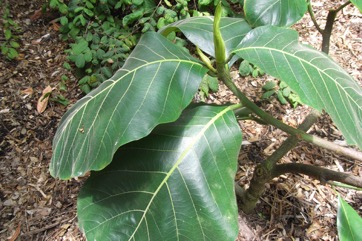
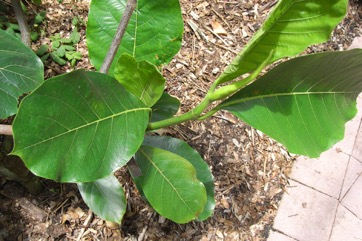
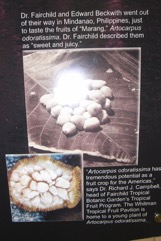
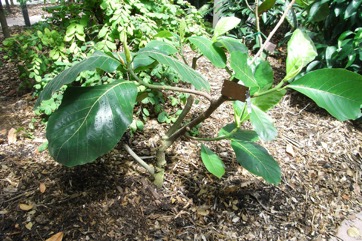
References
Arora, R. K., 2014, Diversity in Underutilized Plant Species - An Asia-Pacific Perspective. Bioversity International. p 59
Bircher, A. G. & Bircher, W. H., 2000, Encyclopedia of Fruit Trees and Edible Flowering Plants in Egypt and the Subtropics. AUC Press. p 43
Brown, W.H., 1920, Wild Food Plants of the Philippines. Bureau of Forestry Bulletin No. 21 Manila. p 44
Burkill, I.H., 1966, A Dictionary of the Economic Products of the Malay Peninsula. Ministry of Agriculture and Cooperatives, Kuala Lumpur, Malaysia. Vol 1 (A-H) p 260
Call, C. A., et al, 2004, Participatory Rural Appraisal in the Upland Ecosystem of Mt Malindang, Misamis Occidental, Philippines. Biodiversity Research Programme for Development in Mindanao. p 53
Chai, P. P. K. (Ed), et al, 2000, A checklist of Flora, Fauna, Food and Medicinal Plants. Lanjak Entimau Wildlife Sanctuary, Sarawak. Forestry Malaysia & ITTO. p 168
Coronel, R.E., 1982, Fruit Collections in the Philippines. IBPGR Newsletter p 6
Darley, J.J., 1993, Know and Enjoy Tropical Fruit. P & S Publishers. p 52
Facciola, S., 1998, Cornucopia 2: a Source Book of Edible Plants. Kampong Publications, p 154
Fl. Filip. 671. 1837
Flowerdew, B., 2000, Complete Fruit Book. Kyle Cathie Ltd., London. p 155
Food Composition Tables for use in East Asia FAO http://www.fao.org/infoods/directory No. 915
Hoare, A., 2003, Food use of the Lundayeh SW Sabah. Borneo Research Council.
Lorenzi, H., Bacher, L., Lacerda, M. & Sartori, S., 2006, Brazilian Fruits & Cultivated Exotics. Sao Paulo, Instituto Plantarum de Estuados da Flora Ltda. p 438
Lyle, S., 2006, Discovering fruit and nuts. Land Links. p 81
Macmillan, H.F. (Revised Barlow, H.S., et al) 1991, Tropical Planting and Gardening. Sixth edition. Malayan Nature Society. Kuala Lumpur. p 293
Martin, F. W., et al, 1987, Perennial Edible Fruits of the Tropics. USDA Handbook 642 p 37
Menninger, E.A., 1977, Edible Nuts of the World. Horticultural Books. Florida p 73
Milow, P., et al, 2013, Malaysian species of plants with edible fruits or seeds and their evaluation. International Journal of Fruit Science. 14:1, 1-27
Monsalud, M.R., Tongacan, A.L., Lopez, F.R., & Lagrimas, M.Q., 1966, Edible Wild Plants in Philippine Forests. Philippine Journal of Science. p 501
PROSEA (Plant Resources of South East Asia) handbook, Volume 2, 1991, Edible fruits and nut. p 94
Septiani, Y. & Sidabutar, H., (Eds.) 2015, Biodiversity Survey. In the Sub Watershed Embaloh, Betung Kerihun National Park. ITTO p 82
Shaffiq, A. M., A., et al, 2013, Marketable wild fruits of Sarawak, Borneo: Their mode of consumption, uses and sugar profiles. Indian Journal of Traditional Knowledge. Vol 12(2): 195-201
Siong, K. H., 2003, Indigenous Fruits of Sarawak. Forest Department Sarawak. p 97
Slik, F., www.asianplant.net
Soepadmo, E. and Saw, L. G., 2000, Tree Flora of Sabah and Sarawak. Forestry Malaysia. Volume Three. p 205
Sukarya, D. G., (Ed.) 2013, 3,500 Plant Species of the Botanic Gardens of Indonesia. LIPI p 139
Tankard, G., 1990, Tropical fruit. An Australian Guide to Growing and using exotic fruit. Viking p 111
Terra, G.J.A., 1973, Tropical Vegetables. Communication 54e Royal Tropical Institute, Amsterdam, p 26
USDA, ARS, National Genetic Resources Program. Germplasm Resources Information Network - (GRIN). [Online Database] National Germplasm Resources Laboratory, Beltsville, Maryland. Available: www.ars-grin.gov/cgi-bin/npgs/html/econ.pl (10 April 2000)
Wickens, G.E., 1995, Edible Nuts. FAO Non-wood forest products. FAO, Rome. p144
World Checklist of Useful Plant Species 2020. Royal Botanic Gardens, Kew